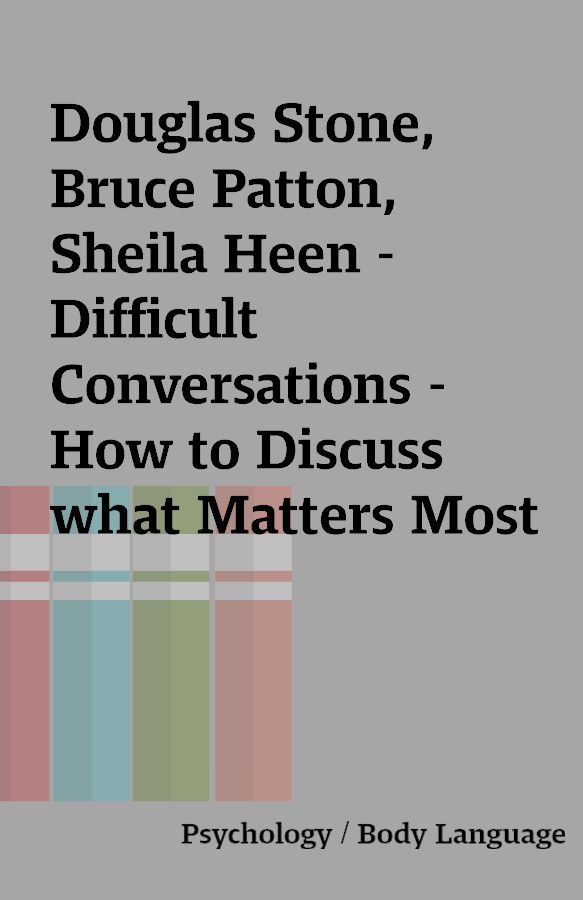Douglas Stone, Bruce Patton, Sheila Heen – Difficult Conversations – How to Discuss what Matters Most
Difficult Conversations (1 to 8)
[8 MP3s]
Description
Re upload:http://www.amazon.com/exec/obidos/ASIN/014028852X/4.5 / 5 stars (148 customer reviews)Amazon.com ReviewWe’ve all been there: We know we must confront a coworker, store clerk, or friend about some especially sticky situation–and we know the encounter will be uncomfortable. So we repeatedly mull it over until we can no longer put it off, and then finally stumble through the confrontation. Difficult Conversations, by Douglas Stone, Bruce Patton, and Sheila Heen, offers advice for handling these unpleasant exchanges in a manner that accomplishes their objective and diminishes the possibility that anyone will be needlessly hurt. The authors, associated with Harvard Law School and the Harvard Project on Negotiation, show how such dialogues actually comprise three separate components: the “what happened” conversation (verbalizing what we believe really was said and done), the “feelings” conversation (communicating and acknowledging each party’s emotional impact), and the “identity” conversation (expressing the situation’s underlying personal meaning). The explanations and suggested improvements are, admittedly, somewhat complicated. And they certainly don’t guarantee positive results. But if you honestly are interested in elevating your communication skills, this book will walk you through both mistakes and remedies in a way that will boost your confidence when such unavoidable clashes arise. –Howard RothmanFrom Publishers WeeklyBringing together the insights of such diverse disciplines as law, organizational behavior, cognitive, family and social psychology and “dialogue” studies, Stone, Patton and Heen, who teach at Harvard Law School and the Harvard Negotiation Project, illustrate how to handle the challenges involved in effectively resolving “difficult conversations,” whether in an interpersonal, business or political context. While many of their points are simplisticAdon’t ignore your feelings, consider the other person’s intentions, take a break from the situationAthey’re often overlooked in stressful moments. Most useful are the strategies for disarming the impulse to lay blame and for exploring one’s own contribution to a tense situation. Also of value are specific recommendations for bringing emotions directly into a difficult discussion by talking about them and paying attention to the way they can subtly inform judgments and accusations. If these recommendations aren’t followed, the authors contend, emotions will seep into the discussion in other, usually damaging, ways. Stone, Patton and Heen illustrate their points with anecdotes, scripted conversations and familiar examples in a clear, easy-to-browse format. While “difficult conversations” may not have the intrinsic appeal of the Harvard Negotiation Project’s previous bestseller, Getting to Yes, this book is a cogent resource for those who see the sense in preparing for tough talks in advance. Agent, Esther Newberg. Ad/promo; author tour. (Apr.) FYI: Patton is the co-author of Getting to Yes.Copyright 1999 Reed Business Information, Inc.The most helpful favorable Amazon.com review:Quote:There were 3 aspects of this book that made a differecne for me: Thinking Differently, Making Shifts, and understanding the Structure found in all difficult conversations. If you understand these aspects it will significantly improve how well you handle difficult conversations.This is about Thinking Differently– 1. This is an approach. 2. It’s not about doing differently; it’s about thinking differently. 3. It’s about shifting from a message delivery stance to a learning stance. 4. All difficult conversations have the same structure. The structure is almost always “below the surface.” It is hidden in what people are thinking and feeling, but not saying.Shifts (with this approach)– We must shift our internal orientation: FROM: Certainty (I understand) TO: Curiosity (Help me understand); FROM: I am right TO: I am curious; FROM: I know what was intended TO:I know the impact; FROM: I know who is to blame TO: I know who contributed what; FROM: Debate TO: Exploration; FROM: Simplicity TO: Complexity; FROM: “Either/or” TO: “And”.Understanding the Structure– 1. All difficult conversations share a common structure. To make the structure visible, we not only need to understand what was said, but also what was not said. We need to understand what the people involved are thinking and feeling, but not saying to each other. This is usually where the real action is. 2. What makes a conversation difficult? The gap between what you are really thinking and what you are saying is part of it. 3. Our thoughts and feelings of all difficult conversations fall into the same three categories, or “conversations”. 4. And, in each of the conversations, we make predictable errors that distort our thoughts and feelings and get us in trouble. 5. There predictable errors can be overcome this specific strategies that the authors suggest.I have developed workshops based on this material that we are finding very helpful in our hospital setting.Spend some time with this book – it will be worth your while.
You must be logged in to post a review.






Reviews
There are no reviews yet.